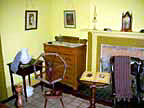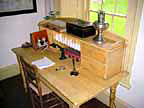|
 Kitchen/Big
Room: The kitchen/big room was the heart of Cove Fort,
and served to express a commitment to hospitality. Food was prepared
in the kitchen and served by the Hinckleys for family members,
hired help, and travelers. Kitchen/Big
Room: The kitchen/big room was the heart of Cove Fort,
and served to express a commitment to hospitality. Food was prepared
in the kitchen and served by the Hinckleys for family members,
hired help, and travelers.
 Specifically,
guests at Cove Fort's kitchen included Latter-day Saint settlers
on their way to new homes, Church leaders visiting the Saints
in outlying settlements, prominent non-LDS leaders such as General
Thomas L. Kane, mail carriers, native tribal members, and travelers
of every description. Specifically,
guests at Cove Fort's kitchen included Latter-day Saint settlers
on their way to new homes, Church leaders visiting the Saints
in outlying settlements, prominent non-LDS leaders such as General
Thomas L. Kane, mail carriers, native tribal members, and travelers
of every description.
The room was
also used for religious services and special meetings. When Brigham
Young and other Church leaders visited the fort, residents and
neighbors would gather here to hear news of the Church and Utah
Territory, and received spiritual support for their endeavors.
 Washing
and Weaving Room:
Home economics were essential to the operations of Cove Fort.
In the washing and weaving room, clothes and dishes were washed
and bodies bathed. In addition, someone sat at the loom and wove
cloth and rag rugs. Washing
and Weaving Room:
Home economics were essential to the operations of Cove Fort.
In the washing and weaving room, clothes and dishes were washed
and bodies bathed. In addition, someone sat at the loom and wove
cloth and rag rugs.
Guest
Rooms:
Travelers and guests at Cove Fort received board in the kitchen
across the courtyard. Those who operated Cove Fort sheltered and
welcomed strangers and travelers.
Hinckley
Family Rooms:
The last three rooms along the north side of the fort served as
a private residence for the Hinckley family. Here they rested
from the labors of caring for travelers and managing the various
operations of the site. This is where they wrote letters, sewed
clothes, cared for children, read, studied, and prayed.
 Telegraph
Office:
The telegraph room was also used as an overflow dining room. The
Cove Fort telegraph station was part of a communications line
that connected Church settlements from north to south by 1866.
Most telegraph communications carried Church and territorial business,
helping to bridge the great distances over which Church members
had settled. Telegraph
Office:
The telegraph room was also used as an overflow dining room. The
Cove Fort telegraph station was part of a communications line
that connected Church settlements from north to south by 1866.
Most telegraph communications carried Church and territorial business,
helping to bridge the great distances over which Church members
had settled.
Stage
and Post Office: The six rooms along the south wall
were used for business, domestic, and social activities. Travelers
could rest and refresh themselves while the stagecoach horse teams
were changed. Coaches stopped at the fort each day, one from the
north and one from the south.
The stagecoach
company owned and boarded stock at Cove Fort. Fresh teams would
be brought from the barn or corral and hitched to the coach parked
outside the gate. Hired hands groomed and fed the teams.
Postal express
riders delivered and picked up mail collected at the fort from
nearby residents, ranches, and miners. One mail carrier, William
Anderson, would leave Fillmore at 6:00 a.m. on Monday and arrive
in Cedar City Wednesday evening near 6:00 p.m. He would average
47 miles a day.
Stagecoach
and postal routes connected the line of settlements that stretched
from Idaho to Nevada and northern Arizona. These settlements were
planned and laid out carefully by Church leaders to find a home
for tens of thousands of immigrant Saints who gathered to the
western United States.
|